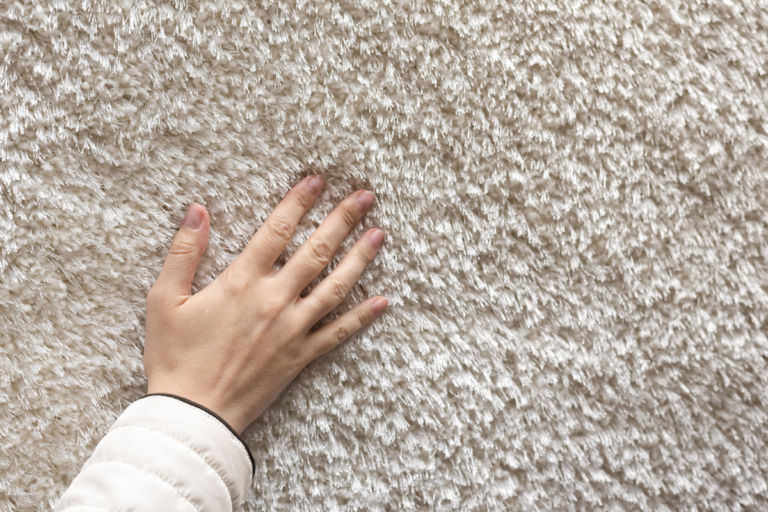There are a few things about an outdoor living space (hi, mold and mildew) that don’t apply indoors.
Indoor rugs have the absolute luxury to be made of natural fibers, like wool rugs, or cotton rugs. While indoor rugs are meant to make your feet feel like they are home, outdoor rugs need to be able to withstand the outdoor elements.
Think: rain, dirt, mud, direct sunlight, and mold and mildew.
Yeah, you can see where this is headed.
Let’s go through all of the things you wanna know about the best outdoor rug materials.
Factors to consider when choosing outdoor rug materials
When it comes to choosing the best outdoor rug material for your outdoor space, there are several super important things you’ll want to pay attention to. Let’s take a closer look at some of the most important factors to keep in mind!
Durability and weather resistance
First and foremost, you’ll want to consider the rug’s durability. After all, outdoor rugs are exposed to a lot of wear and tear, including heavy foot traffic, weather, and UV rays. Look for the best outdoor rugs, made from durable materials that can stand up to the elements without fading, fraying, or losing their shape over time.
PRO TIP: Get something stain resistant as well. Trust me.
Outdoor rugs also need to be able to withstand rain, wind, and sun without getting waterlogged, mold and mildew-ed, or sun-bleached. This means that you’ll want something water resistant so that it can withstand humid climates or wet ground.
Don’t worry, I’ll get into the most durable materials in a little bit.
Comfort and softness
Comfort and softness are also important factors to consider, especially for outdoor space, if you plan to spend a lot of time sitting or lounging on your outdoor rug. Look for rugs that feel soft and plush underfoot, and that provide a comfortable surface for relaxation and play.
There are a few materials that are known for their softness and durability outdoors:
- Polyethylene: This synthetic material is often used for outdoor rugs because of its softness and comfort underfoot. Polyethylene rugs are also resistant to stains and fading, making them a great choice for outdoor areas.
- Polyester: This synthetic material is also known for its softness and affordability. It’s also resistant to stains and fading, which makes it a popular choice for high-traffic outdoor areas.
- Natural materials (e.g. bamboo, jute): Natural fibers like bamboo and jute are also great options for outdoor rugs, as they’re soft and comfortable underfoot, and can withstand exposure to the elements.
To really add some comfort and keep things from getting moldy underneath the rug, add a waterproof rug pad underneath. Try out my quiz to find the right rug pad for you:
Not sure which rug pad to get?
Take the quiz to get started!
We recommend:
Eco-friendliness
Finally, eco-friendliness is an increasingly important consideration for many people. If you’re looking for an outdoor rug that’s environmentally friendly, look for rugs made from recycled materials or that are designed to be recyclable at the end of their lifespan.
When it comes to finding an eco-friendly outdoor rug that can withstand exposure to the elements, there are a few materials that are worth considering:
- Recycled plastics: Many outdoor rugs are made from recycled plastics, which can include everything from water bottles to milk jugs. These materials are often durable, moisture-resistant, and easy to clean, making them a great choice for outdoor use. If possible, look for outdoor rugs made with recycled synthetic fibers.
- Bamboo: Bamboo is a fast-growing, renewable resource that’s known for its strength and durability. It’s also naturally resistant to moisture and pests, which makes it a great choice for outdoor rugs.
- Jute: Jute is another natural fiber that’s often used for outdoor rugs. It’s biodegradable and renewable, and has a soft, natural texture that’s comfortable underfoot.
- Recyclable materials: Some outdoor rug manufacturers are now designing rugs that are made to be recyclable at the end of their lifespan. These rugs are often made from materials like polypropylene, which can be recycled into new products.
Best materials for outdoor rugs
While it’s true that synthetic materials like polypropylene, polyethylene, and polyester are not naturally eco-friendly, they do have some environmental benefits when used as outdoor rugs.
For example, these materials are often made from recycled plastic, which can help to reduce waste and conserve natural resources. Synthetic fibers for rugs tend to have a longer lifespan than natural fiber rugs, which means they need to be replaced less often and create less waste over time.
Synthetic rug materials are often more resistant to the elements than natural fibers, which means they can withstand exposure to sun, rain, and wind without deteriorating as quickly. This means that synthetic outdoor rugs have a lower environmental impact over time, as they require less maintenance, cleaning, and replacement than natural fiber rugs.
While synthetic materials may not be the most eco-friendly option, they do have some environmental benefits when used in outdoor rugs, particularly when made from recycled materials and used for their durability and longevity.
THAT BEING SAID, here are my favorite materials for outdoor rugs.
Polypropylene
Polypropylene is a synthetic material that’s commonly used for outdoor rugs. It’s made from a type of plastic called polypropylene resin, which is melted down and extruded into fibers that are then woven into a rug.
Polypropylene is a great choice for outdoor rugs because it’s durable, moisture-resistant, and easy to clean. It’s also resistant to fading and UV rays, which means it won’t lose its color or shape over time.
Polypropylene is generally considered to be safe and low-VOC (volatile organic compound). Unlike some other synthetic materials, polypropylene doesn’t release harmful chemicals into the air, which makes it a great choice for families with young children or pets.
Benefits:
- Durable and long-lasting
- Resistant to moisture and mildew
- Easy to clean and maintain
- Affordable
Polyester
Polyester is a synthetic material that’s often used for outdoor rugs. It’s made from a type of plastic called polyethylene terephthalate (PET), which is melted down and extruded into fibers that can be woven into a rug.
Polyester is a great choice for outdoor rugs because it’s soft, comfortable, and affordable. It’s also resistant to stains, fading, and moisture, which means it can withstand exposure to the elements without deteriorating over time.
Polyester is generally considered to be safe and low-VOC (volatile organic compound). It doesn’t release harmful chemicals into the air, which makes it a great choice for families with young children or pets.
Benefits:
- Soft and comfortable underfoot
- Affordable
- Resistant to stains and fading
- Durable and long-lasting
Natural materials (e.g. bamboo, jute)
Natural materials like bamboo and jute are great options for outdoor rugs. Bamboo is a fast-growing and renewable resource that’s known for its strength and durability. It’s naturally moisture-resistant and can withstand exposure to the elements without deteriorating.
Jute is another natural fiber that’s often used for outdoor rugs. It’s biodegradable and renewable, and has a soft, natural texture that’s comfortable underfoot.
Natural materials like bamboo and jute are generally considered to be safe and eco-friendly. They’re free of harmful chemicals and pesticides, which makes them a great choice for people who are sensitive to synthetic materials.
However, it’s worth noting that natural fiber rugs may require a bit more maintenance than synthetic materials, as they can be more prone to staining and fading. While homegirl is usually all about the natural and eco-friendly options, in this case, it is a bit trickier. Stick with the durable natural fibers like bamboo, sea grass, and jute.
Benefits:
- Eco-friendly
- Soft and comfortable underfoot
- Durable and long-lasting
- Naturally moisture-resistant
How to care for outdoor rugs
Even if you snagged a stain resistant outdoor rug, you’ll still need to clean it every once in a while.
General cleaning tips
Just like with any cleaning schedule, you’ll need to take care of this bad boy periodically.
Regularly sweep or vacuum your outdoor rug to remove dirt, dust, and debris. Spot-clean spills and stains as soon as possible to prevent them from setting.
Dyson Cyclone V10 Absolute Lightweight Cordless Stick Vacuum Cleaner
The Dyson Cyclone V10 Absolute is a top-of-the-line cordless stick vacuum cleaner that is lightweight, easy to maneuver, and powerful enough to tackle even the toughest messes. With its innovative design and multiple attachments, the V10 Absolute is a versatile cleaning tool that can handle everything from area rugs to hard floors to tight corners and crevices.
Hose down your outdoor rug and let it air dry at least once a year to remove dirt and debris that can accumulate over time. Avoid using harsh chemicals or cleaners on your outdoor rug, as they can damage the material and compromise its durability.
Specific care instructions for each material
- Polypropylene: To clean a polypropylene outdoor rug, use a mixture of mild soap and water and scrub gently with a soft-bristled brush. Rinse with a hose and let air dry. Avoid using bleach or harsh chemicals on polypropylene rugs.
- Polyethylene: To clean a polyethylene outdoor rug, use a mixture of mild soap and water and scrub gently with a soft-bristled brush. Rinse with a hose and let air dry. Avoid using bleach or harsh chemicals on polyethylene rugs.
- Polyester: To clean a polyester outdoor rug, use a mixture of mild soap and water and scrub gently with a soft-bristled brush. Rinse with a hose and let air dry. Avoid using bleach or harsh chemicals on polyester rugs.
- Natural materials (e.g. bamboo, jute): To clean a natural fiber outdoor rug, use a mixture of mild soap and water and scrub gently with a soft-bristled brush. Rinse with a hose and let air dry. Avoid getting natural fiber rugs too wet, as this can cause them to mold or rot.
Tips for extending the lifespan of outdoor rugs
- Avoid placing outdoor rugs in areas that receive direct sunlight for long periods of time, as this can cause fading and deterioration.
- Rotate your outdoor rug periodically to prevent wear and tear in one area.
- Store your outdoor rug in a dry, protected area during the off-season to prevent damage from moisture, pests, and other environmental factors.
- Use a rug pad underneath your outdoor rug to provide cushioning and prevent slipping or sliding.
- Trim any loose fibers or frayed edges as soon as you notice them, to prevent further damage.
Final thoughts
I’ve shared the best outdoor rugs, so go forth and decorate your outdoor space. Let me know in the comments which outdoor rug you ended up with!



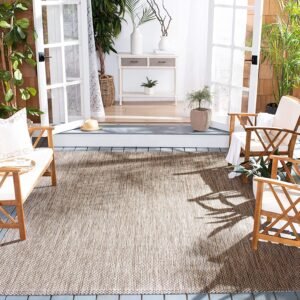


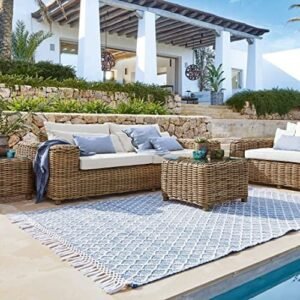
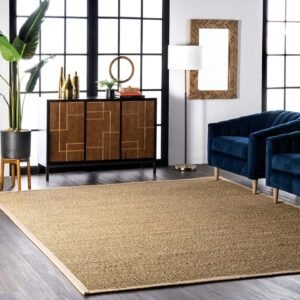


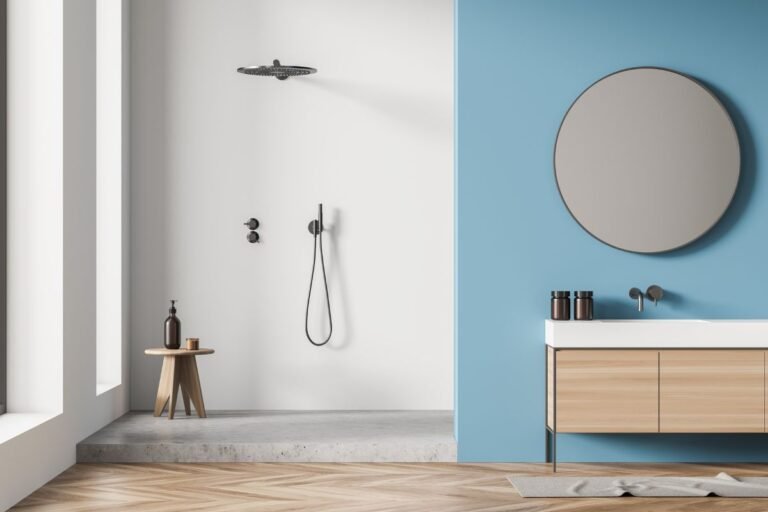
![[SOLVED] Best vacuum for area rugs in 2023](https://rugsandpads.com/wp-content/uploads/2023/02/best-vacuum-for-area-rugs-768x512.jpg)
